

PAGE 35
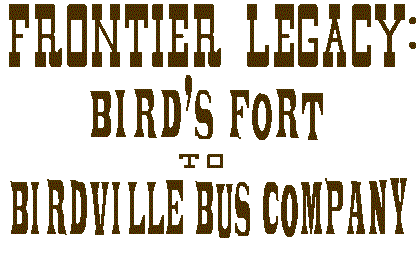
The token:
BIRDVILLE / (bus) / BUS CO. GOOD FOR / (bus) / ONE FAREBronze-round-23millimeters diameter (circa: 1952, listed in "The Atwood-Coffee Catalog" as TX340P, book value = $7.50, estimated value = $25)
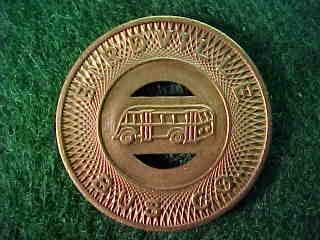
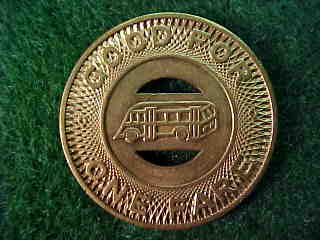
PREFACE
It was Saturday, November 21st, 1998, and the alarm went off at 3 AM, I met Bob Smith in Arlington at 4 AM for the drive to Houston. The Texas token meeting was the first I had been to in years. Bob Smith had agreed to drive his car the ten hours we would be on the road, which is the hardest thing about the long trip. I met many collectors that had been known to me only by name, through letters and emails. Some of the "old time" collectors that I had not seen in years were there also. It was a pleasant blend of "new" collectors, and old friends, buying, selling and trading tokens. You hope that you can make a few nice additions to your collection.
Fortunately, John B. had two identical tokens for sale. Otherwise Robert S. and I may have slugged it out trying to buy the Birdville Bus token hidden away in John’s three ring binders. Even though the token is not as old as I am, it has eluded me for twenty years while prowling flea markets, coin shows, garage sales etc.
The Birdville bus token although dating from the 1950’s, is one of the only remaining numismatic legacies of a Texas name some 160 years old.
WHERE IS BIRDVILLE?
The Birdville Bus token, is listed as a Fort Worth, Texas token, and I accept that classification. Birdville is no longer a separate town, or even a community. A local school district is still called Birdville Independent School District, and it’s schools fall in several Fort Worth suburban towns, including North Richland Hills, Haltom City, and Richland Hills. The name of Birdville is a historic name in Tarrant County, and goes back to the 1840’s. The actual site of Birdville is in Haltom City, Texas, and the original site of Bird’s Fort is in the city of Euless, Texas.
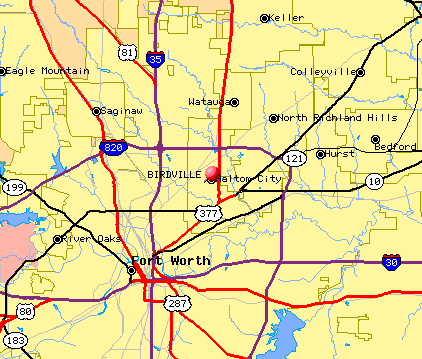
The name Birdville, was originally a small community that derived its name from an even earlier one named Bird’s Fort, whose name was taken from Captain Jonathon Bird.
THE LOG FORT OF 1840
Texas became an independent republic on 2 March 1836 (four days before the fall of the Alamo), with Sam Houston as the first president.
Indian attacks on the few white settlements in the north central area of the Republic of Texas were so numerous between 1837 and 1840 that few whites had ventured past the Holland Coffee trading post in Grayson County. The closest town to the site at that time, was Clarksville, Texas. The area is located in what is called the "cross timbers", which is a large area of mainly post oak and black oak trees growing in a sandy loam deposited by rivers cut through the Texas plains.
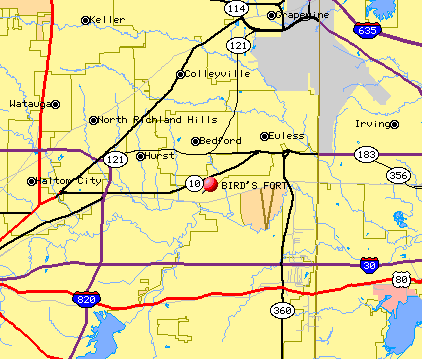
The first white settlement in what is now Tarrant County, Texas, was established in 1840, by Captain Jonathan Bird and a company of about 20 Texas Rangers, at a small lake about 16 miles east of the junction of the Clear and West Forks of the Trinity River. The exact location of Bird’s Fort, was on the north side of the Trinity River, and about 6 miles north of present day Arlington, near Calloways Lake. A log blockhouse and defensive earthworks were constructed for protection from Indian attacks.
Captain Bird and the 20 Texas Rangers (3-month service tours) lived in the rude log houses during the winter of 1840. However, by the spring of 1841, Bird and the rangers abandoned the site.
THE FIGHT AT VILLAGE CREEK
On May 24, 1841, about 7 miles south west of Bird’s Fort, near a small stream (later named Village Creek) flowing into the Trinity River, General Edward Tarrant, Captain John B. Denton and Captain Bourland led a band of 69 militia men on horseback in an attack on a very large group of Indian villages, which stretched up the creek for about 5 miles. Some of the tribes in the villages included Cherokee, Creek, Seminole, Waco, Caddoes, Kickapoo, Anadarko, Kickais, Ionies and others. The Indians were farmers, having 300 acres in corn in the bottoms, and the raiding party counted 225 Indian lodges. The only white casualty of the action was Captain Denton, for whom the city and county of Denton are named.
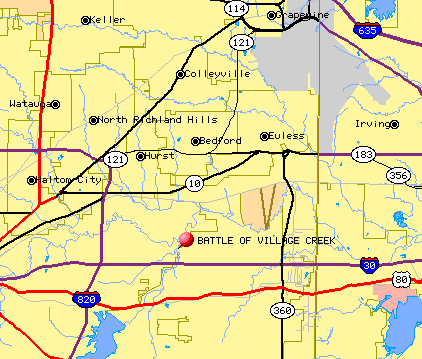
THE SECOND OCCUPATION OF BIRD’S FORT
In the fall of 1841, three families moved into the recently abandoned fort, and remained there all winter. Their occupation lasted only until the spring of 1842. The men had nearly starved to death at the fort, as all grass had been burned off, and game was scarce. The party had brought little provisions with them, and so in November of 1841, sent a wagon to a settlement on the Red River for provisions. At Bird’s Fort, a not-so-merry Christmas came and went with no sign of the relief wagon. Three men were sent out in search for the wagon. It was a harsh winter for northern Texas, and the men and horses tramped through 6 inches of snow. Near the present city of Carrolton in Dallas County, the men saw a tree with a large hive of honeybees. After dismounting and attempting to smoke out the bees, they were attacked by Indians, and one was killed by an arrow through the heart.
SAM HOUSTON AND THE INDIANS AT BIRD’S FORT
Sam Houston, the hero of San Jacinto, headed the Republic of Texas. Houston was beginning his second term as president of the new republic in December of 1841, with intent to solve the "Indian problem." His proposed solutions were based on peaceful coexistence, and mutual benefits.
Houston wrote " I do not doubt that this system, once established, would conciliate the Indians, open a lucrative commerce with them, and bring continued peace to our entire frontier."
Sam Houston President 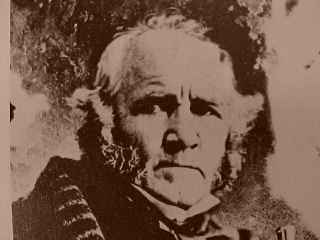 of the Republic of Texas
of the Republic of Texas
Sam Houston invited the chiefs of all the tribes of the northern areas of the Republic of Texas to a peace council, to be held at Bird’s Fort, in August of 1843. Houston traveled from Washington-on-the-Brazos northward, and arrived safely at Bird’s Fort in the first week of August 1843. Many tribes had arrived and camped in the area. Most spoke different languages but communicated through sign language. Houston waited for the missing tribes to arrive, through most of August, and finally began the council. The two main missing tribes were the Commanche and Wichita.
The Bird’s Fort Treaty was signed September 29, 1843 by Texas commissioners and representatives of the Delaware, Chickasaw, Waco, Tawakoni, Kichai, Caddo, Anadarko, Ioni, Biloxi and Cherokee. It’s basic tenants were establishing a line, "where the west began", which basically ran from Fort Worth to Menard and San Antonio. The treaty also stipulated that whites could only west of the boundary only by permission of the president, and Indians were not to cross east of the line except with permission of an (Indian) agent. It also promised that blacksmiths and teachers were to be sent to the tribes.
TEXAS BECOMES A STATE
Texas became a state on 29 December 1845, as the 28th state of the union. The treaty opened the area for settlement, and Birdville was a functioning community by 1848. In 1849 the Texas legislature established Tarrant County. One year later, the small community in present day Haltom City near Carson and Broadway streets, took the name of Birdville. (This community called Birdville was about 12 miles west of the site of Bird’s Fort.) It was selected as the county seat. 1851 opened a post office. A rivalry developed between the small settlement at Fort Worth, and the county seat of Birdville. An election in 1856 moved the county seat from Birdville, to Fort Worth. Birdville lost by only 7 votes.
Birdville had two newspapers in the 1850’s, one called the Birdville Western Express which was founded in 1855, was the first newspaper in Tarrant County. A second paper called The Birdville Union, whose editor, A. G. Walker, had strong union sympathies. The Birdville Western Express was founded by John J. Courtney, who was a supporter of secession from the union. The war of words between these two editors escalated, until it ended in a gun battle in the streets of Birdville, in which Walker killed Courtney.
Birdville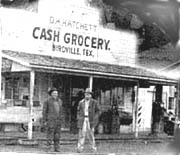 Texas
Texas
By 1870, Birdville had four general stores, and a blacksmith shop. By 1896 there was a public school for black children which had 14 pupils and one for white children which had 77 pupils. The post office of Birdville closed in 1906, when the reported population was at 107. The population was reported at about 400 in the 1950’s and it was annexed by the city of Haltom City. The name of Haltom City comes from the early jeweler G. W. Haltom, who started his Fort Worth business in 1903, and built a 4,000-acre ranch in the area in the 1930’s.
THE NAME BIRDVILLE TODAY
Today, the name of Birdville lives on, mainly in a large school district, which has three large high schools, and numerous grade schools. The story goes that when the incorporation of the town (in 1949) was being considered, the names proposed were Birdville and Haltom City. As a compromise, the city was named Haltom City, and the school district was to be called Birdville. Amazingly many of the people in the school district do not like the name of Birdville, and seek to change the name to something sounding more cosmopolitan. None of the high schools are named Birdville, rather Haltom High, and Richland High, and the mascots do not reflect the obvious possibilities hinted at by the district name.
Go to page 36 of our token web pages...
updated: 2 may 2001